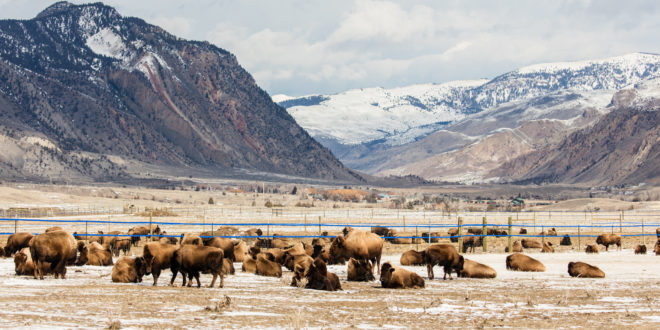Yellowstone National Park has released more information about yesterday’s incident at the Stephens Creek bison facility.
We reported yesterday that over 50 bison had been released from the facility after someone cut the fences to two pens. Reportedly, the fences were cut with a bolt cutter. We also reported that a criminal investigation had been opened into the incident.
According to a Yellowstone press release, 52 bull bison escaped from Stephens Creek. 24 of those bulls had been in the facility since March 2016, while the remaining 28 had been there since March 2017. Park staff discovered the hole the morning of January 16, 2018.
As of writing (1/17/18), none of the quarantined bison have been located (UPDATE 1/18/18: Some of the escaped bison have been found Mammoth Hot Springs). From the press release:
“This is an egregious criminal act that sets back bison conservation. It delays critical ongoing discussions about a quarantine program and the transfer of live Yellowstone bison to tribal lands. The park is aggressively investigating this incident,” said Yellowstone National Park Superintendent Dan Wenk.
“I am absolutely heartbroken for the Fort Peck Tribes who have been working with the park, the state of Montana, and Animal and Plant Health Inspection Service for years to repatriate these bison,” said [Interior Secretary Ryan] Zinke. “The criminals who broke into a national park facility to release these bison put at risk the safety of the animals that are now at risk of being culled and our park rangers who are rounding them up. I will be working with Secretary Perdue to see if we can get back on track to transfer the brucellosis free bulls to the tribe this year.”
The release adds that the Stephens Creek facility is “closed permanently” to the public. We previously reported that the park had instituted their annual temporary closure of public access to the Stephens Creek area.
The bison being held were originally slated to go to the Fort Peck Indian Reservation in eastern Montana after undergoing quarantine for brucellosis, a disease prevalent in the Yellowstone bison herd. Each winter, bison moving north out of the park are either corralled into Stephens Creek and shipped for slaughter or shot by hunters under the Interagency Bison Management Plan, which aims to curb bison numbers and prevent the spread of brucellosis to cattle.
To date, there has never been a documented case of bison-to-cattle brucellosis transmission; new research also shows that elk are far likelier to infect cattle with brucellosis than bison.
The IBMP has drawn severe criticism from conservation and wildlife advocacy groups, who view it as unnecessary, egregious, and detrimental to the bison’s long term survival. Others have cast doubt on the efficacy and ethicality of quarantine, saying bison should be allowed to roam, not treated like domesticated cattle.
Indeed, earlier this year, conservation groups called on livestock producers to take more responsibility for brucellosis prevention, including vaccination, rather than pushing that responsibility onto wildlife and park managers.
The 24 bison that have been held at Stephens Creek since 2016 are the remnant of 40 bison (including female bison) originally promised to the Fort Peck Tribes. They were originally slated for slaughter—to make room for bison corralled during the 2017 winter season—until Montana Governor Steve Bullock intervened. After negotiations with state and federal livestock agencies, all parties agreed to spare the bull bison and slaughter the females.
At the time, Fort Peck Chairman Floyd Azure called the move “a slap in the face,” since the Tribes hope to establish a viable herd on the reservation.
Under this compromise, the 24 bulls would be quarantined and shipped to Fort Peck at a later date. Initially, they were set to go to Corwin Springs. This summer, however, Yellowstone proposed converting part of the Stephens Creek facility into a quarantine facility. As of writing, the park had made several modifications to some pens at Stephens Creek in order to be compliant with state and federal quarantine regulations.
 Yellowstone Insider Your Complete Guide to America's First National Park
Yellowstone Insider Your Complete Guide to America's First National Park





